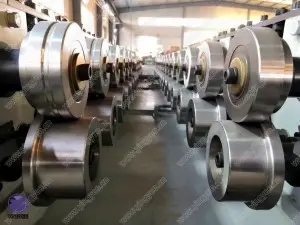
Understanding the Wall Angle Light Keel Forming Machine A Comprehensive Overview
In the construction and manufacturing industries, the wall angle light keel forming machine plays a pivotal role in producing structural components that support various building frameworks. This specialized machinery is designed to create wall angles and light keels from metal strips, transforming basic materials into vital components for interior construction projects.
The Functionality of the Wall Angle Light Keel Forming Machine
At its core, the wall angle light keel forming machine is engineered to shape steel or aluminum strips into specific profiles that serve as support structures for drywall, ceilings, and partition walls. These profiles are crucial for providing stability, flexibility, and strength in building designs. The machine operates via a series of processes, including feeding, forming, cutting, and sometimes punching, to produce these profiles efficiently and accurately.
The machine typically consists of several key components
1. Feeding Mechanism This component pulls metal coils from a reel and feeds them into the forming sections of the machine. Depending on the model, it may employ automatic or manual feeding systems to ensure a continuous supply of material.
2. Forming Stations As the metal strip advances, it passes through multiple rollers that gradually shape the strip into the desired angle. The forming process is critical, as precision is required to achieve angles that fit the design specifications.
3. Cutting Device After the forming process, the machine cuts the profiles to predetermined lengths. This can be achieved using various cutting methods, including shearing or flying cuts, which allows for high-speed production without stopping the entire process.
4. Control System Modern machines often come equipped with advanced control systems that include programmable logic controllers (PLCs) to manage every aspect of the forming process. This enhances precision, reduces waste, and improves overall efficiency.
Advantages of Using Wall Angle Light Keel Forming Machines
The adoption of wall angle light keel forming machines brings numerous benefits to construction and manufacturing operations, including
1. Increased Efficiency These machines can produce high volumes of keels and angles in a short time, significantly reducing the labor required for manual production methods. Automated processes lead to faster turnaround times on construction projects.

2. Cost-Effectiveness By minimizing labor costs and maximizing material use, businesses can greatly reduce overhead. Additionally, improved accuracy leads to less material waste, further enhancing cost savings.
3. Customization Many forming machines offer customization options, allowing manufacturers to create profiles in varying dimensions and specifications to meet specific project needs. This versatility is a considerable advantage in today’s competitive environment.
4. Quality Assurance With precise controls and automated features, these machines produce uniform and consistent products, ensuring quality standards are met. Consistency in profile quality is essential for structural integrity in construction.
5. Ease of Operation With user-friendly interfaces and advanced technology, operating these machines requires less specialized training than traditional methods. This accessibility allows for a broader range of personnel to manage production.
Applications in the Construction Industry
The wall angle light keel forming machine serves a variety of applications within the construction industry. Primarily, it is utilized to manufacture
- Drywall Framing These profiles are integral for constructing walls and ceilings. Lightweight yet strong, they facilitate the easiness of installation for drywall, ensuring that buildings remain stable and durable.
- Suspended Ceilings Light keels produced by these machines provide the necessary support for suspended ceiling grids, allowing for flexible designs and easy access to utilities.
- Partition Walls In commercial and residential spaces, these profiles are essential for creating temporary or permanent partition walls, making it easy to adapt spaces to changing needs.
Conclusion
The wall angle light keel forming machine is an indispensable tool in modern manufacturing and construction. Its ability to efficiently produce customizable, high-quality profiles makes it a cornerstone for any project involving drywall or partition construction. By integrating such machinery into their operations, businesses can enhance their production capabilities, improve quality, and ultimately achieve greater customer satisfaction in their offerings. As the construction industry continues to evolve, equipment like the wall angle light keel forming machine will remain vital for successful project execution.